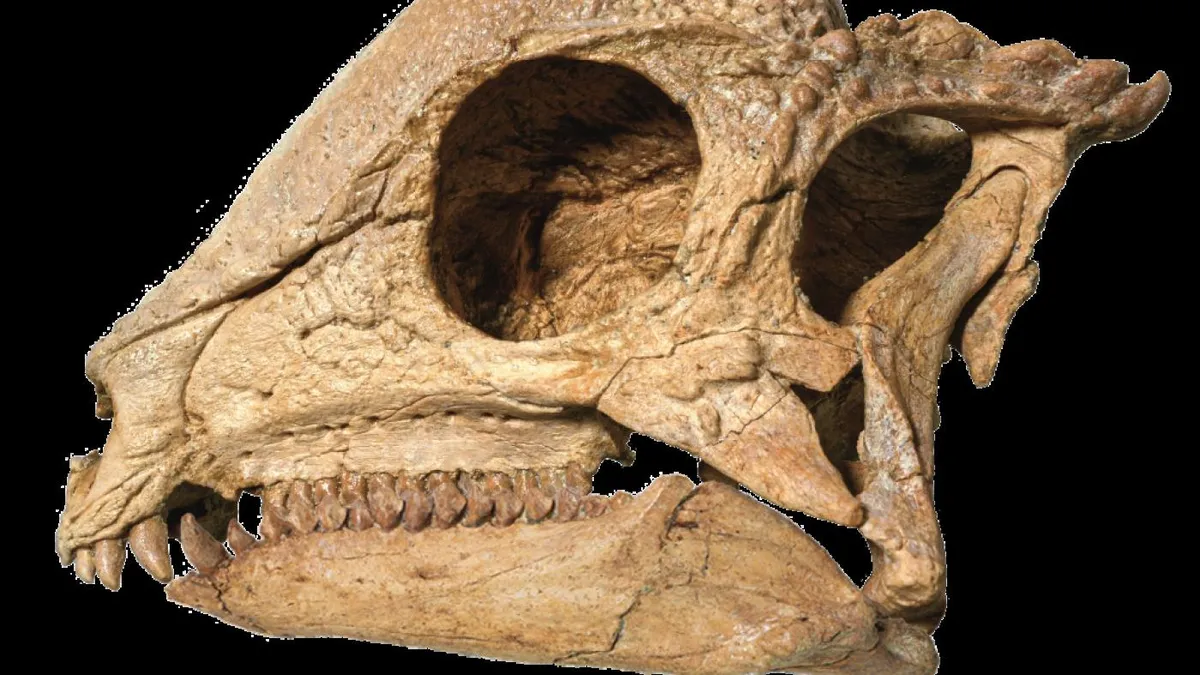
On a cloudy morning in southeast Mongolia, paleontologist Chinzorig Tsogtbaatar and his dedicated team embarked on an expedition from their campsite towards a rocky outcrop that dates back approximately 110 million years to the early Cretaceous period. After a trek of 15 to 20 minutes, Tsogtbaatar noticed a peculiar bright object on the opposite side of a hill. “It didn’t look like a rock,” he recalled, feeling the thrill of discovery surge within him. Upon closer inspection, he quickly recognized the remarkable find: a dome-shaped skull.
This unexpected encounter led Tsogtbaatar, who now works at North Carolina State University, to identify a new species of pachycephalosaur—a distinctive group of dinosaurs characterized by their thick, bony, hemispherical skulls, about which little is known. The excitement was palpable, as Tsogtbaatar recalled, “In that moment, we just stopped breathing.” This discovery is groundbreaking; it marks the first definitive pachycephalosaur ever found from the early Cretaceous. Colleague Lindsay Zanno, also a paleontologist at North Carolina State University and head of paleontology at the North Carolina Museum of Natural Sciences, emphasized its significance, noting, “It just pops out of the fossil record with a fully developed dome and bells and whistles on its head.”
In a recent publication in the journal Nature, Tsogtbaatar, Zanno, and their team introduced the world to this new dinosaur species, which they named Zavacephale rinpoche. The term “rinpoche” is Tibetan for "precious one," aptly reflecting the stunning domed skull that appeared to Tsogtbaatar like a polished jewel during his expedition.
The newly discovered specimen is remarkable not only for its beauty but also for its age; it is 15 million years older than the previous oldest known pachycephalosaur. This discovery fills a crucial gap in our understanding of the early evolution of these fascinating dome-headed dinosaurs. According to David Evans, a dinosaur paleontologist at the Royal Ontario Museum in Toronto, “This dinosaur fills in a critical gap in the early evolution of this famous group.” After its excavation in 2019, the fossil was preserved in Mongolia during the pandemic and was finally transported to North Carolina in 2022 for further analysis.
Zanno expressed her enchantment upon first seeing the skull in the lab, stating, “Everyone just stood around the lab holding this precious, incredible skull. It’s just the most beautiful specimen. It’s magical.” The domed head—comprised of solid bone and adorned with spikes—is the defining feature of any pachycephalosaur. “Their domes are essentially indestructible,” Zanno noted, suggesting that these dinosaurs were likely engaged in head-butting behavior, possibly for mating or territorial disputes.
Despite the wealth of knowledge about their skulls, researchers have historically struggled to understand the overall anatomy of pachycephalosaurs due to the scarcity of fossilized remains. However, during the excavation in Mongolia, the team uncovered dozens of additional bones from Zavacephale rinpoche, resulting in the most complete pachycephalosaur skeleton ever discovered. Zanno described its size, comparing it to that of a German shepherd, while noting that 75% of the body comprises the neck and tail, leading to a lightweight structure of about 12 pounds.
This juvenile fossil has already yielded significant insights. Analysis of its stomach contents revealed small stones that would have aided in digestion, while the tail featured bony tendons, enhancing its rigidity. Notably, this is the first instance of pachycephalosaur hand bones being identified. Zanno remarked on their tiny size, initially leading the team to believe they were foreign objects ingested by the dinosaur rather than parts of its own body. Furthermore, the limb bones provided crucial information about the dinosaur's age, confirming it was at least two years old, indicating that young pachycephalosaurs like this one possessed fully developed domes.
The specimen has returned to the Institute of Paleontology of the Mongolian Academy of Sciences, aligning with the nation’s commitment to safeguarding its natural and cultural heritage. Cary Woodruff, a curator of vertebrate paleontology at the Frost Museum of Science in Miami, expressed admiration for the discovery, intertwining his amazement with a hint of friendly jealousy. “How he even found the specimen is just bonkers,” Woodruff remarked about Tsogtbaatar’s incredible find. “He doesn’t just find a new one. He doesn’t just find the geologically oldest one. He finds what everyone who works on pachycephalosaurs has always wanted to find.”
In closing, Evans echoed this sentiment, expressing astonishment at the beauty and completeness of the fossil, stating, “I was just stunned by the beauty and completeness of this particular fossil. This is a specimen that we’ll be learning from for many, many years to come.” The discovery of Zavacephale rinpoche not only enhances our understanding of pachycephalosaurs but also ignites excitement for future paleontological explorations in Mongolia and beyond.